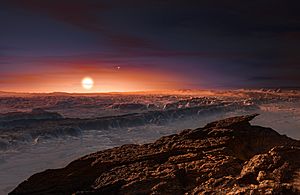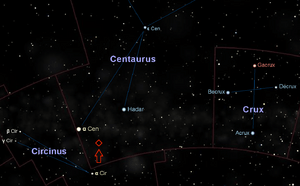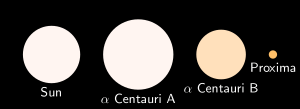Proxima Centauri facts for kids
Proxima Centauri is a small, cool star called a red dwarf. It is the closest star to our Sun! It's about 4.22 light-years (3.99×1013 km; 2.48×1013 mi) away. You can find it in the constellation of Centaurus.
Scientists think Proxima Centauri is part of a bigger star system called Alpha Centauri. It was first found in 1915 by Robert Innes in South Africa. In 1951, Harlow Shapley noticed that Proxima Centauri is a special kind of star called a flare star. This means it can suddenly get much brighter, like a flash!
Contents
About Proxima Centauri
Red dwarfs like Proxima Centauri are usually too dim to see without a telescope. Proxima Centauri is very faint. Even if you were on one of the other stars in the Alpha Centauri system, Proxima Centauri would still look quite dim.
Proxima Centauri has been the closest star to our Sun for a very long time, about 32,000 years! Another star called Barnard's Star will come closer to the Sun in about 9,700 years. But even then, Proxima Centauri will still be the closest star to us.
Planets Around Proxima Centauri

In 2016, scientists found a planet orbiting Proxima Centauri. It's called Proxima Centauri b (or Proxima b). This planet is special because it's in the "habitable zone." This means it's not too hot and not too cold for liquid water to exist on its surface, which is important for life!
Even though Proxima b is in the habitable zone, it might be a tough place to live. Proxima Centauri is a flare star, so it sends out strong bursts of energy and wind. These bursts could make it hard for the planet to keep its atmosphere. If a planet loses its atmosphere, it's much harder for life to exist. Scientists are still studying if Proxima b could have oceans or a thin atmosphere.
In 2019, another planet was found, called Proxima Centauri c. This planet is much farther away from the star than Proxima b. It's also much bigger, about seven times heavier than Earth. Because it's so far out, it's too cold for liquid water. Scientists think it might even have a huge ring system, much bigger than Jupiter's rings!
Related pages
Images for kids
-
Alpha Centauri AB is the bright star to the left, which forms a triple star system with Proxima Centauri, circled in red. The bright star system to the right is Beta Centauri.
-
Overview and comparison of the orbital distance of the habitable zone.
See also
 In Spanish: Próxima Centauri para niños
In Spanish: Próxima Centauri para niños





